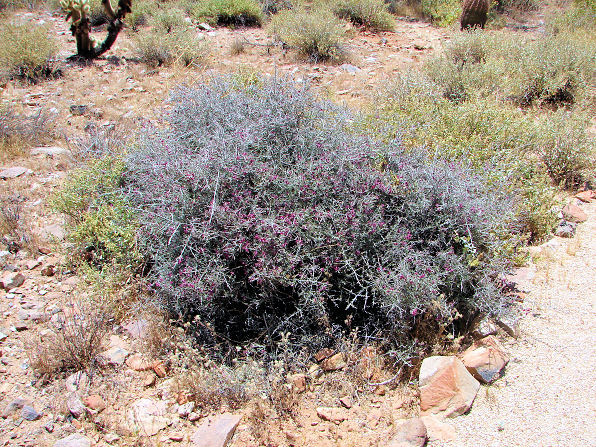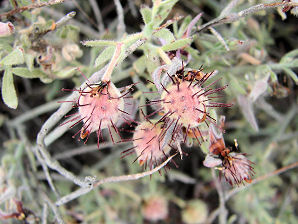Arizona Wild Flowers
Pictures, Photos, Images
Descriptions, Information, Reviews.
White Ratany, Krameria grayi.
We Are Proud Of Our SafeSurf Rating!
Click On Any Of The Following Links By Amazon.Com
For Books, & Videos About Wildflowers Of Arizona & The Southwest USA. No Obligation!
 |
| White Ratany, Krameria grayi. Flowering Photos Taken April 23, 2008. Mayo Clinic Scottsdale Nature Trail. |
|---|
 | |
| White Ratany, Krameria grayi | White Ratany, Krameria grayi |
|---|---|
 |  |
| White Ratany, Krameria grayi | White Ratany, Krameria grayi |
 |  |
| White Ratany, Krameria grayi | White Ratany, Krameria grayi |
 /
/

White Ratany.
We wish to thank Wikipedia, the free encyclopedia for some of the information on this page. We share images and information with Wikipedia.
White Ratany is a perennial, low and densely branched, deciduous shrub up to about 3 feet high and 3 feet wide that is common in desert scrub throughout the Trans-Pecos, and west to California and south into Mexico. It has slender, thorny stems that are more noticeable than its tiny leaves. When they emerge they are whitish and hairy and then they mature to be smooth and gray. The whitish color gives it the common name of White Ratany. Its small, reddish-purple flowers are borne profusely in the late spring and also in the fall after the summer monsoons. K. grayi and K. erecta look almost the same, but K. grayi has recurved sepals, a separate petal, and inside the flower there are orange gland - like petals. Krameria is very drought resistant and it is an excellent Xeriscape plant. However, it is a partial root parasite of other nearby plants. So try not to plant too close to other plants. I have found it to be OK about two feet away from neighboring plants. The root system is shallow, with 40 percent of the root mass in the top 4 inches of the soil, and spreads horizontally and radially. Ratany offer their bee pollinators oil instead of nectar. The oil bees (Centris) acquire nectar from other plants, but scrape off the oil from ratany to combine with pollen from other plants to feed their larvae. The Papago Indians used an infusion of the twigs externally for treating sore eyes and internally for dysentery. The roots provided them with a red dye for wool and other materials. The dye was also used as an ink. White Ratany provides thermal cover for rattlesnakes (Crotalus spp.) and the western whiptail (Cnemidophorus tigris) [25]. Small mammals, such as the Bailey's pocket mouse (Perognathus baileyi), use White Ratany for hiding cover. White Ratany is an important forage species for all classes of livestock and for deer (Odocoileus spp.) It also provides cover for small mammals and reptiles. Palatability of White Ratany is rated fair to good for cattle and sheep. Mule and white-tailed deer browse White Ratany year-long with seasonal peaks. Mule deer peak use is from February to April and from August to October, and white-tailed deer peak use is from August to October. Range Ratany and White Ratany look almost the same. The flowers of White Ratany have a non-cupped bottom sepal and Range Ratany does not.
Quick Notes:
Height: Up To About 6 inches - 36 inches Tall.
Flowers: About 3/4� wide, each on a slender stalk bearing many gland-tipped hairs; sepals 5, reddish lavender inside; upper 3 petals much smaller than sepals, reddish lavender, joined awith green bases. lower 2 petals resembling small, greenish pads.
Stems: Stems are spineless but taper to a sharp point.
Flowering Time: Mid - March - May and again in Mid - July - September. Mainly Mid - March - May.
Fruit: Fruit is a fuzzy greenish-white ball with barbed spines. The pod turns lavender white with age, it has lavender barbs. The pod contains one seed. White Ratany does not have spines along the entire length of the seed pod.
Seeds: Seed pods 1 - 1 1/2" long, 3/8 - 1/2" in diameter; a cylindrical pod; short-pointed at ends, reddish; maturing in summer, remaining attached, often opening late; many elliptical flattened shiny brown; seeds.
Leaves: Leaves are inconspicuous, simple, smooth-edged to lobed, narrow, grayish-green, haired, about 1/4" - 1/2� long, very narrow, gray, hairy, reddish prickles, each with scattered barbs near tip.
Found: Native to southwestern United States, and northern Mexico. Mainly, the Trans-Pecos area, southern Nevada, Utah, Arizona, California and Sonora, Mexico.
Hardiness:
Soil pH requirements:
Sun Exposure:
Elevation: 1,000 to 4,000 Feet.
Habitat: White Ratany's habitat is the desert environs, where it occupies open, sandy to rocky flats, bajadas, and playas. Creosote Bush Scrub, Joshua Tree Woodlands. An ideal xeriscape landscape plant in Arizona.
Miscellaneous: Flowering Photos Taken April 23, 2008. Mayo Clinic Scottsdale, Arizona Nature Trail..
|



We Are Proud Of Our SafeSurf Rating!
Click On Any Of The Following Links By Amazon.Com
For Books, & Videos About Xerioscape Plants Of Arizona & The Southwest USA. No Obligation!
Back To Arizona Wild Flowers Home Page.
Back To Arizona Wild Flowers, Blue Violet Page Four.
Back To Arizona Xeriscape Landscaping Main Page.
Back To Xeriscape Shrubs Page Nine.
Back To DeLange Home Page
© 1966 - Present, Audrey, Eve, & George DeLange
| © 1966 - Present, Audrey, Eve, & George DeLange |


